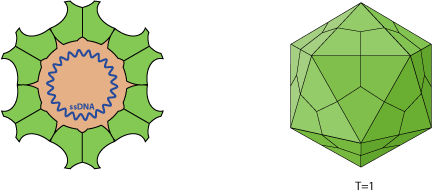VIRION

Non-enveloped, round, T=1 icosahedral symmetry, about 20 nm in diameter. The capsid consists of 12 pentagonal trumpet-shaped pentamers.
GENOME
Monopartite, circular, ssDNA genome of about 1.8 to 3.8 kb.
The genome is replicated through double-stranded intermediates. The replication (Rep) protein initiates rolling circle replication.
GENE EXPRESSION
One or two mRNAs encode for the Rep, capsid, and possibly others proteins. Some mRNA can undergo alternative splicing.
ENZYMES
REPLICATION
NUCLEAR
- Virus penetrates into the host cell.
- Uncoating, the viral ssDNA genome penetrates into the nucleus.
- Viral ssDNA is converted into dsDNA with the participation of cellular factors. dsDNA transcription gives rise to viral mRNAs.
- Viral mRNAs are translated to produce viral proteins.
- Replication may be mediated by a Rep protein, and would occur by rolling circle replication producing ssDNA genomes.
- These newly synthesized ssDNA can either
a) be converted to dsDNA and serve as a template for transcription/replication
b) be encapsidated by capsid protein and form virions released by cell lysis.


